Schmitt C.B. (ed.) The Cambridge History of Renaissance Philosophy
Подождите немного. Документ загружается.

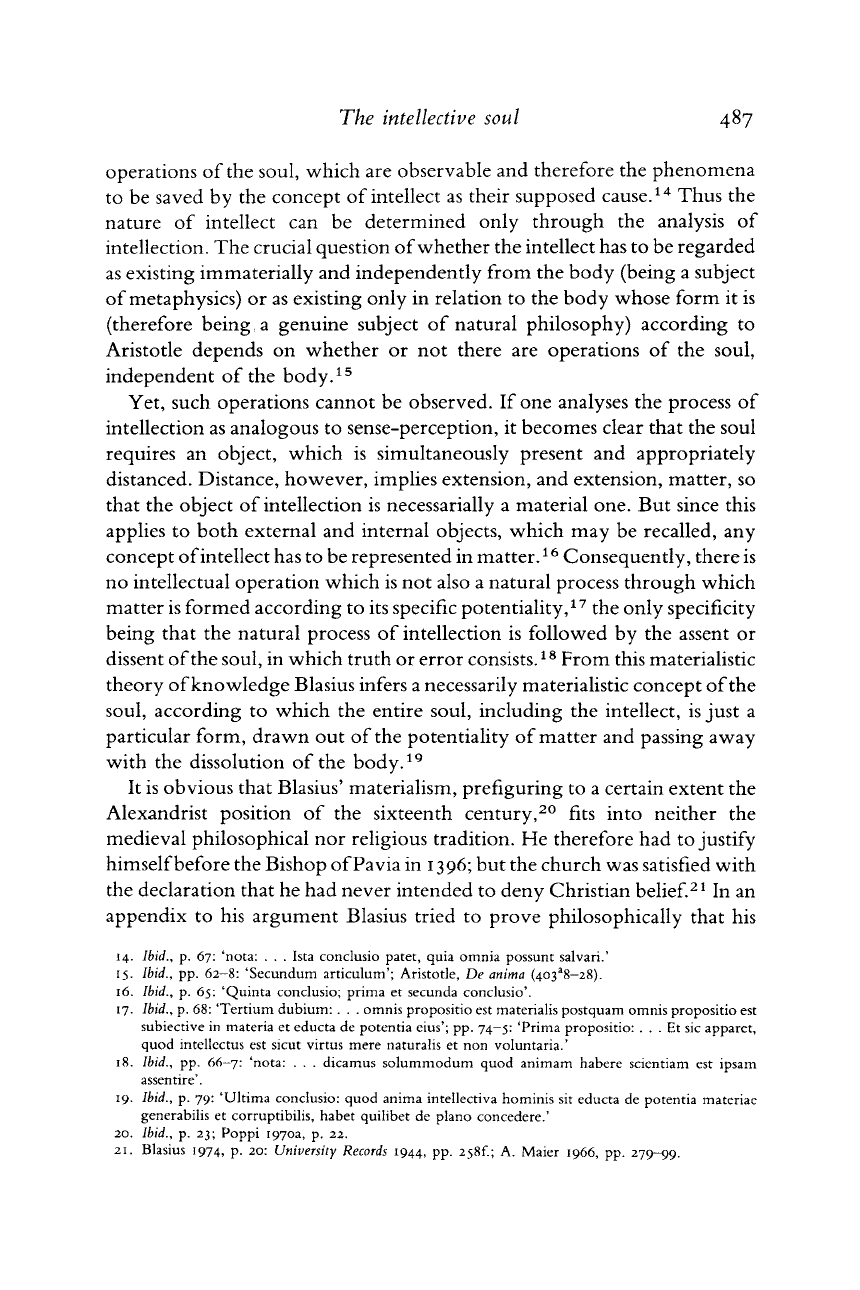
The
intellective
soul
487
operations
of
the
soul, which are observable and therefore the phenomena
to
be saved by the concept of intellect as their supposed cause.
14
Thus the
nature
of intellect can be determined only through the analysis of
intellection. The
crucial
question
of
whether
the intellect has to be
regarded
as
existing immaterially and independently from the body (being a subject
of
metaphysics)
or as existing only in relation to the body whose form it is
(therefore
being a genuine subject of
natural
philosophy) according to
Aristotle
depends on whether or not there are operations of the soul,
independent of the body.
15
Yet,
such operations cannot be observed. If one analyses the process of
intellection as analogous to sense-perception, it becomes
clear
that the soul
requires
an object, which is simultaneously present and appropriately
distanced.
Distance, however, implies extension, and extension,
matter,
so
that
the object of intellection is necessarially a material one. But since this
applies to both external and internal objects, which may be recalled, any
concept
of
intellect has to be
represented
in
matter.
16
Consequently,
there
is
no intellectual operation which is not also a
natural
process through which
matter
is formed according to its specific potentiality,
17
the only specificity
being that the
natural
process of intellection is followed by the assent or
dissent
of
the
soul, in which
truth
or
error
consists.
18
From
this
materialistic
theory
of
knowledge Blasius infers
a
necessarily
materialistic
concept
of
the
soul, according to which the entire soul, including the intellect, is just a
particular
form, drawn out of the potentiality of
matter
and passing away
with the dissolution of the body.
19
It
is obvious that Blasius' materialism, prefiguring to a
certain
extent the
Alexandrist
position of the sixteenth century,
20
fits into neither the
medieval philosophical nor religious tradition. He therefore had to justify
himself
before
the Bishop
of
Pavia
in
1396;
but the
church
was satisfied with
the
declaration that he had never intended to deny Christian belief.
21
In an
appendix
to his argument Blasius tried to prove philosophically that his
14.
Ibid., p. 67:
'nota:
. . . Ista
conclusio
patet, quia
omnia
possunt
salvari.'
15.
Ibid., pp. 62-8:
'Secundum
articulum'; Aristotle, De anima
(403
a
8-28).
16.
Ibid., p. 65: 'Quinta
conclusio;
prima et
secunda
conclusio'.
17.
Ibid., p. 68: 'Tertium dubium: . . .
omnis
propositio
est
materialis
postquam
omnis
propositio
est
subiective
in materia et educta de
potentia
eius';
pp. 74-5: 'Prima
propositio:
. . . Et sic apparet,
quod
intellectus
est
sicut
virtus
mere
naturalis
et non voluntaria.'
18.
Ibid., pp. 66-7:
'nota:
. . .
dicamus
solummodum
quod
animam
habere
scientiam
est
ipsam
assentire'.
19.
Ibid., p. 79: 'Ultima
conclusio:
quod
anima
intellectiva
hominis
sit educta de
potentia
materiae
generabilis
et corruptibilis, habet
quilibet
de
plano
concederé.'
20. Ibid., p. 23; Poppi 1970a, p. 22.
21.
Blasius
1974, p. 20: University Records 1944, pp.
258f.;
A. Maier 1966, pp.
279-99.
Cambridge Histories Online © Cambridge University Press, 2008
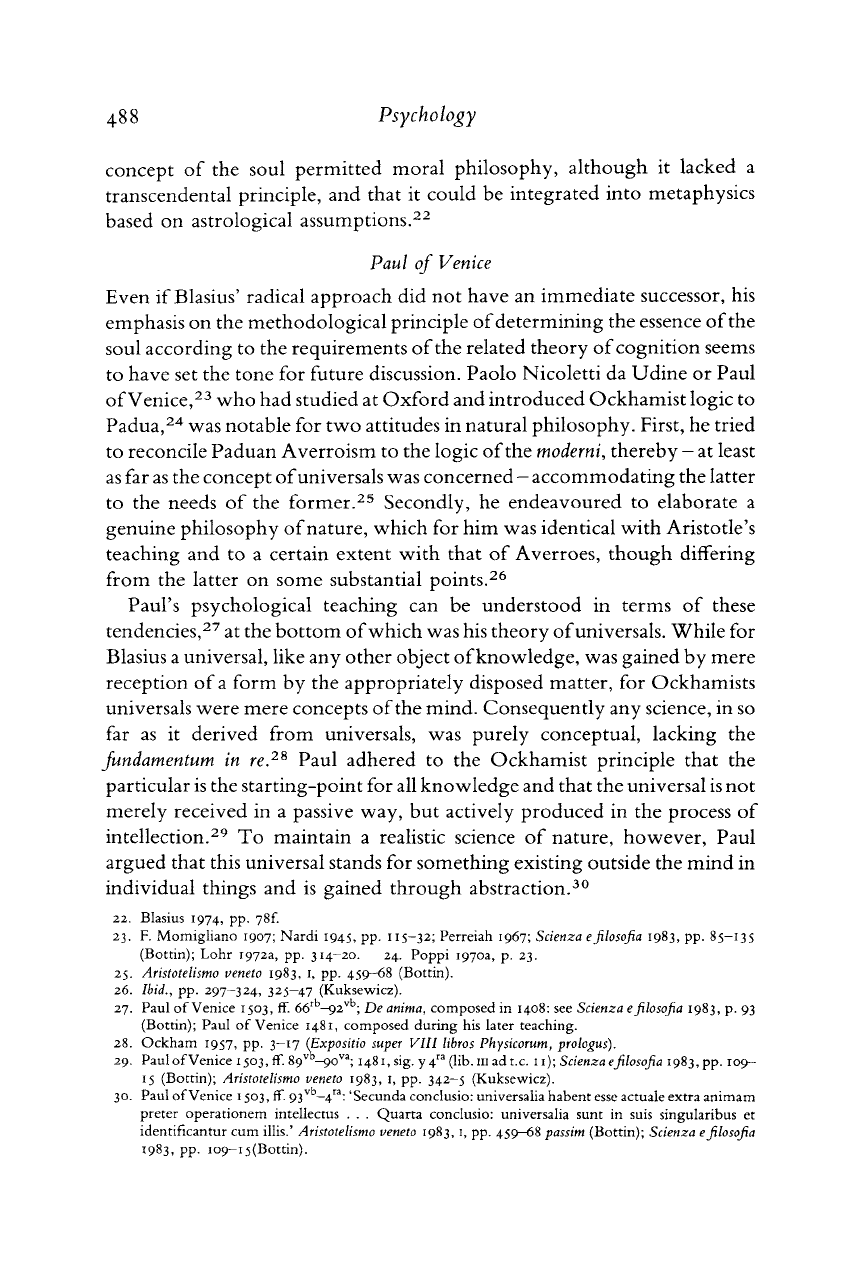
488
Psychology
concept of the soul permitted moral philosophy, although it lacked a
transcendental
principle, and that it could be integrated into metaphysics
based on astrological assumptions.
22
Paul
of
Venice
Even
if
Blasius'
radical approach did not have an immediate successor, his
emphasis on the methodological principle
of
determining the essence
of
the
soul according to the requirements
of
the related theory
of
cognition seems
to
have set the tone for future discussion. Paolo Nicoletti da Udine or Paul
of
Venice,
23
who had studied at Oxford and introduced Ockhamist logic to
Padua,
24
was notable for two attitudes in
natural
philosophy.
First,
he tried
to
reconcile Paduan Averroism to the logic
of
the
moderni,
thereby
—
at least
as
far
as
the concept
of
universals was concerned
—
accommodating the
latter
to
the needs of the former.
25
Secondly, he endeavoured to elaborate a
genuine philosophy
of
nature,
which for him was identical with Aristotle's
teaching and to a certain extent with that of Averroes, though differing
from
the latter on some substantial points.
26
Paul's psychological teaching can be understood in terms of these
tendencies,
27
at the bottom
of
which was his theory
of
universals. While for
Blasius a universal,
like
any other object
of
knowledge, was gained by mere
reception of
a
form by the appropriately disposed
matter,
for Ockhamists
universals were mere concepts
of
the mind. Consequently any science, in so
far
as it derived from universals, was purely conceptual, lacking the
fundamentum
in
re.
28
Paul adhered to the Ockhamist principle that the
particular
is the starting-point for all knowledge and that the universal is not
merely received in a passive way, but actively produced in the process of
intellection.
29
To maintain a realistic science of nature, however, Paul
argued
that this universal stands for something existing outside the mind in
individual things and is gained through abstraction.
30
22.
Blasius
1974, pp. 78f.
23. F.
Momigliano
1907; Nardi 1945, pp. 115-32;
Perreiah
1967; Scienza efilosofia 1983, pp. 85-135
(Bottin);
Lohr 1972a, pp.
314-20.
24.
Poppi
1970a, p. 23.
25. Aristotelismo veneto 1983, 1, pp.
459-68
(Bottin).
26. Ibid., pp.
297-324,
325-47
(Kuksewicz).
27. Paul of
Venice
1503, ff.
66
rb
~92
vb
;
De anima,
composed
in 1408: see Scienza e filosofia 1983, p. 93
(Bottin);
Paul of
Venice
1481,
composed
during
his
later
teaching.
28. Ockham 1957, pp. 3-17 (Expositio super VIII libros Physicorum, prologus).
29. Paul of
Venice
1503, ff.
89
vb
-90
va
;
1481, sig. y4
ra
(lib. in ad t.c.
11);
Scienza efilosofia 1983, pp. 109-
15
(Bottin);
Aristotelismo veneto 1983, 1, pp.
342-5
(Kuksewicz).
30. Paul of
Venice
1503, ff. 93
vb
—4™:
'Secunda
conclusio:
universalia
habent
esse
actuale
extra
animam
preter
operationem
intellectus
. . . Quarta
conclusio:
universalia
sunt
in
suis
singularibus
et
identificantur
cum
illis.'
Aristotelismo veneto 1983,1, pp.
459-68
passim
(Bottin);
Scienza efilosofia
1983, pp.
109-15(Bottin).
Cambridge Histories Online © Cambridge University Press, 2008
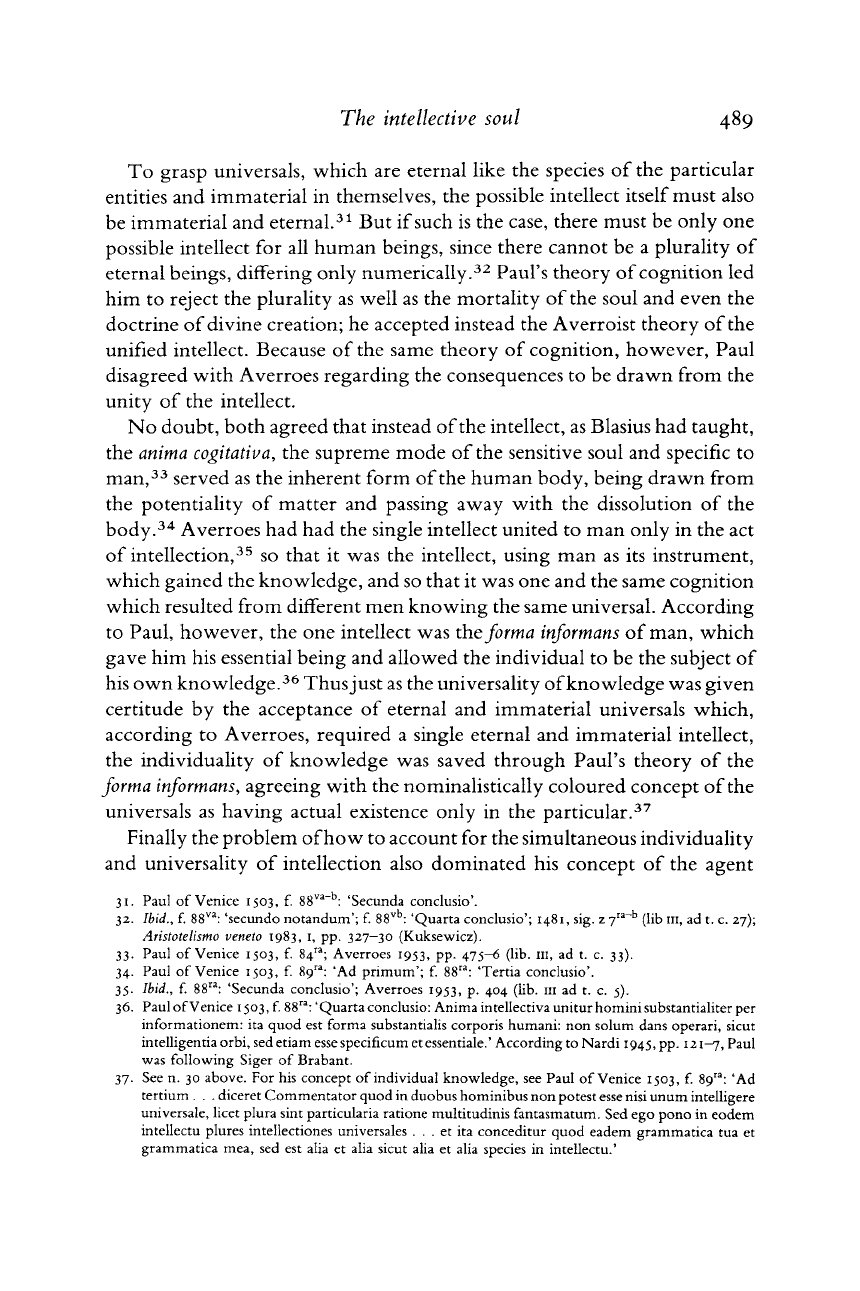
The
intellective
soul
489
To
grasp universals, which are eternal like the species of the
particular
entities and immaterial in themselves, the possible intellect itself must also
be immaterial and eternal.
31
But if such is the case, there must be only one
possible intellect for all human beings, since there cannot be a plurality of
eternal
beings, differing only numerically.
32
Paul's theory
of
cognition led
him to reject the plurality as
well
as the mortality of the soul and even the
doctrine
of divine
creation;
he accepted instead the Averroist theory of the
unified intellect. Because of the same theory of cognition, however, Paul
disagreed with Averroes regarding the consequences to be drawn from the
unity of the intellect.
No doubt, both agreed that instead
of
the
intellect, as Blasius had taught,
the
anima
cogitativa,
the supreme mode of the sensitive soul and specific to
man,
33
served as the inherent form
of
the
human body, being drawn from
the
potentiality of
matter
and passing away with the dissolution of the
body.
34
Averroes had had the single intellect united to man only in the act
of
intellection,
35
so that it was the intellect, using man as its instrument,
which gained the knowledge, and so that it was one and the same cognition
which resulted from different men knowing the same universal. According
to
Paul, however, the one intellect was
the
forma
informans
of
man,
which
gave him his essential being and allowed the individual to be the subject of
his own knowledge.
36
Thus
just
as
the universality
of
knowledge was given
certitude
by the acceptance of eternal and immaterial universals which,
according
to Averroes, required a single eternal and immaterial intellect,
the
individuality of knowledge was saved through Paul's theory of the
forma
informans,
agreeing with the nominalistically coloured concept
of
the
universals as having actual existence only in the
particular.
37
Finally
the problem
of
how to account for the simultaneous individuality
and
universality of intellection also dominated his concept of the agent
31.
Paul of
Venice
1503, f.
88
va-b
:
'Secunda
conclusio'.
32. Ibid., f.
88
va
:
'secundo
notandum';
f.
88
vb
:
'Quarta
conclusio';
1481, sig. z 7
ra_b
(lib m, ad t. c. 27);
Aristotelismo
veneto 1983, 1, pp.
327-30
(Kuksewicz).
33. Paul of
Venice
1503, f. 84"; Averroes 1953, pp.
475-6
(lib. in, ad t. c. 33).
34. Paul of
Venice
1503, f. 89": 'Ad primum'; f.
88
ra
:
'Tertia
conclusio'.
35. Ibid., f.
88
ra
:
'Secunda
conclusio';
Averroes 1953, p. 404 (lib. in ad t. c. 5).
36. Paul of
Venice
1503, f.
88
ra
:
'Quarta
conclusio:
Anima
intellectiva
unitur
homini
substantialiter
per
informationem:
ita
quod
est
forma
substantialis
corporis
humani:
non
solum
dans
operari,
sicut
intelligentia
orbi, sed
etiam
esse
specificum
et
essentiale.'
According to Nardi 1945, pp.
121-7,
Paul
was
following
Siger
of Brabant.
37. See n. 30 above. For his
concept
of
individual
knowledge,
see Paul of
Venice
1503, f. 89": 'Ad
tertium
. . .
diceret
Commentator
quod
in
duobus
hominibus
non
potest
esse
nisi
unum
intelligere
universale,
licet
plura
sint
particularia
ratione
multitudinis
fantasmatum.
Sed ego
pono
in
eodem
intellectu
plures
intellectiones
universales
. . . et ita
conceditur
quod
eadem
grammatica tua et
grammatica mea, sed est
alia
et
alia
sicut
alia
et
alia
species
in
intellectu.'
Cambridge Histories Online © Cambridge University Press, 2008
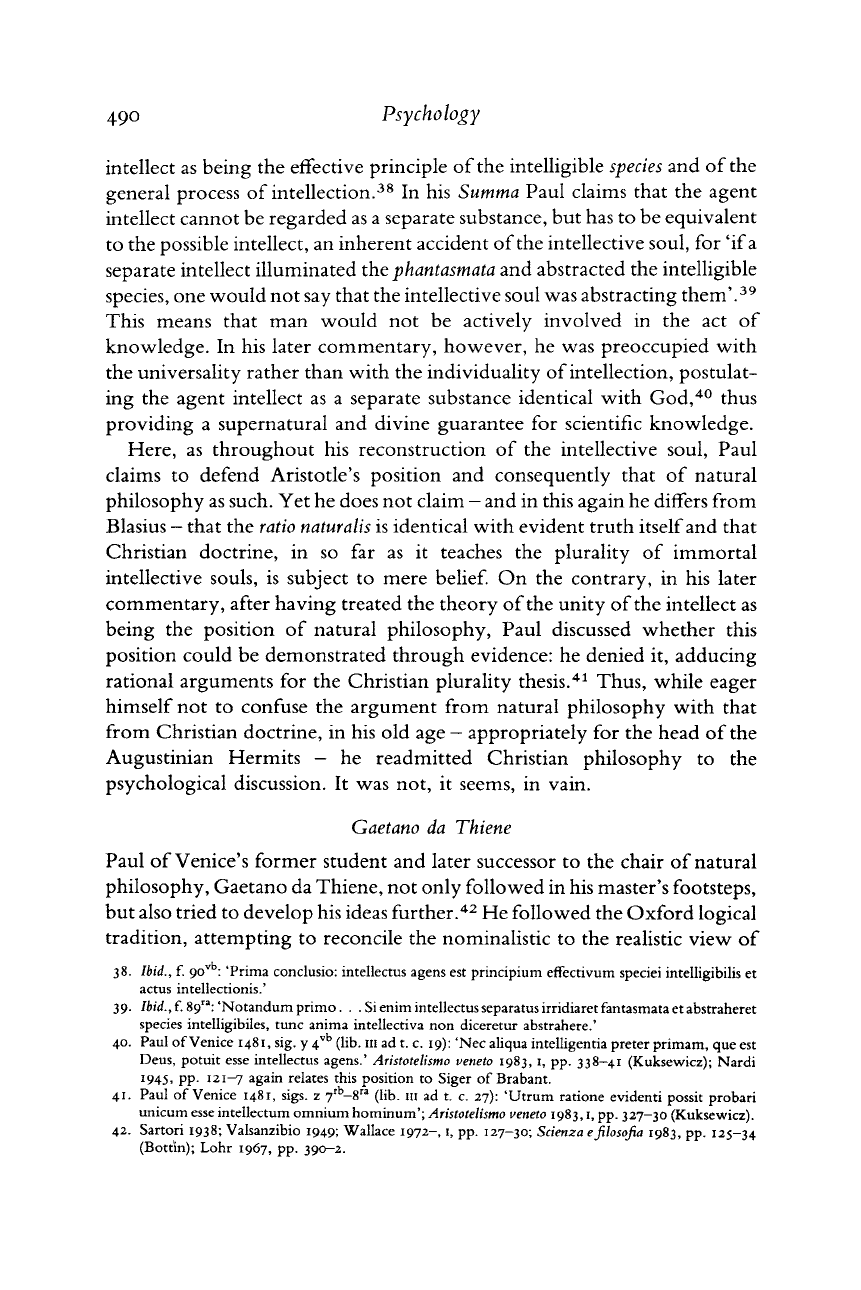
490
Psychology
intellect as being the effective principle of
the
intelligible
species
and of the
general
process of intellection.
38
In his Summa Paul claims that the agent
intellect cannot be
regarded
as a
separate
substance, but has to be equivalent
to
the possible intellect, an inherent accident
of
the
intellective soul, for
'if
a
separate
intellect illuminated the
phantasmata
and
abstracted
the intelligible
species, one would not say that the intellective soul was
abstracting
them'.
39
This
means that man would not be actively involved in the act of
knowledge. In his
later
commentary, however, he was preoccupied with
the
universality
rather
than with the individuality
of
intellection, postulat-
ing the agent intellect as a separate substance identical with God,
40
thus
providing a supernatural and divine guarantee for scientific knowledge.
Here,
as throughout his reconstruction of the intellective soul, Paul
claims
to defend Aristotle's position and consequently that of
natural
philosophy as such. Yet he does not claim
—
and in this again he differs from
Blasius
—
that the
ratio
naturalis
is identical with evident
truth
itself
and
that
Christian
doctrine, in so far as it teaches the plurality of immortal
intellective souls, is subject to mere belief. On the
contrary,
in his
later
commentary,
after
having treated the theory
of
the
unity
of
the
intellect as
being the position of
natural
philosophy, Paul discussed whether this
position could be demonstrated through evidence: he denied it, adducing
rational
arguments for the Christian plurality thesis.
41
Thus, while eager
himself not to confuse the argument from
natural
philosophy with that
from
Christian doctrine, in his old age
—
appropriately
for the head of the
Augustinian Hermits - he readmitted Christian philosophy to the
psychological discussion. It was not, it seems, in vain.
Gaetano
da
Thiene
Paul
of Venice's former student and
later
successor to the
chair
of
natural
philosophy, Gaetano da Thiene, not only followed in his
master's
footsteps,
but
also tried to develop his ideas
further.
42
He followed the Oxford logical
tradition,
attempting to reconcile the nominalistic to the realistic view of
38. Ibid., f.
90
vb
:
'Prima
conclusio:
intellectus
agens
est
principium
effectivum
speciei
intelligibilis
et
actus
intellectionis.'
39. Ibid., f. 89": 'Notandum primo... Si
enim
intellectus
separatus
irridiaret fantasmata et abstraheret
species
intelligibiles,
tunc
anima
intellectiva
non
diceretur
abstrahere.'
40. Paul of Venice 1481, sig. y 4
vb
(lib. m ad t. c. 19): 'Nec aliqua
intelligentia
prêter
primam, que est
Deus,
potuit
esse
intellectus
agens.'
Aristotelismo ueneto 1983, 1, pp.
338-41
(Kuksewicz); Nardi
1945, pp. 121-7 again
relates
this
position
to Siger of Brabant.
41.
Paul of Venice 1481,
sigs.
z
7
rb
-8
ra
(lib. m ad t. c. 27): 'Utrum
ratione
evidenti
possit
probari
unicum
esse
intellectum
omnium
hominum';
Aristotelismo veneto 1983,1, pp.
327-30
(Kuksewicz).
42. Sartori 1938; Valsanzibio 1949; Wallace 1972-, 1, pp. 127-30; Scienza
efilosofia
1983, pp. 125-34
(Bottln); Lohr 1967, pp.
390-2.
Cambridge Histories Online © Cambridge University Press, 2008
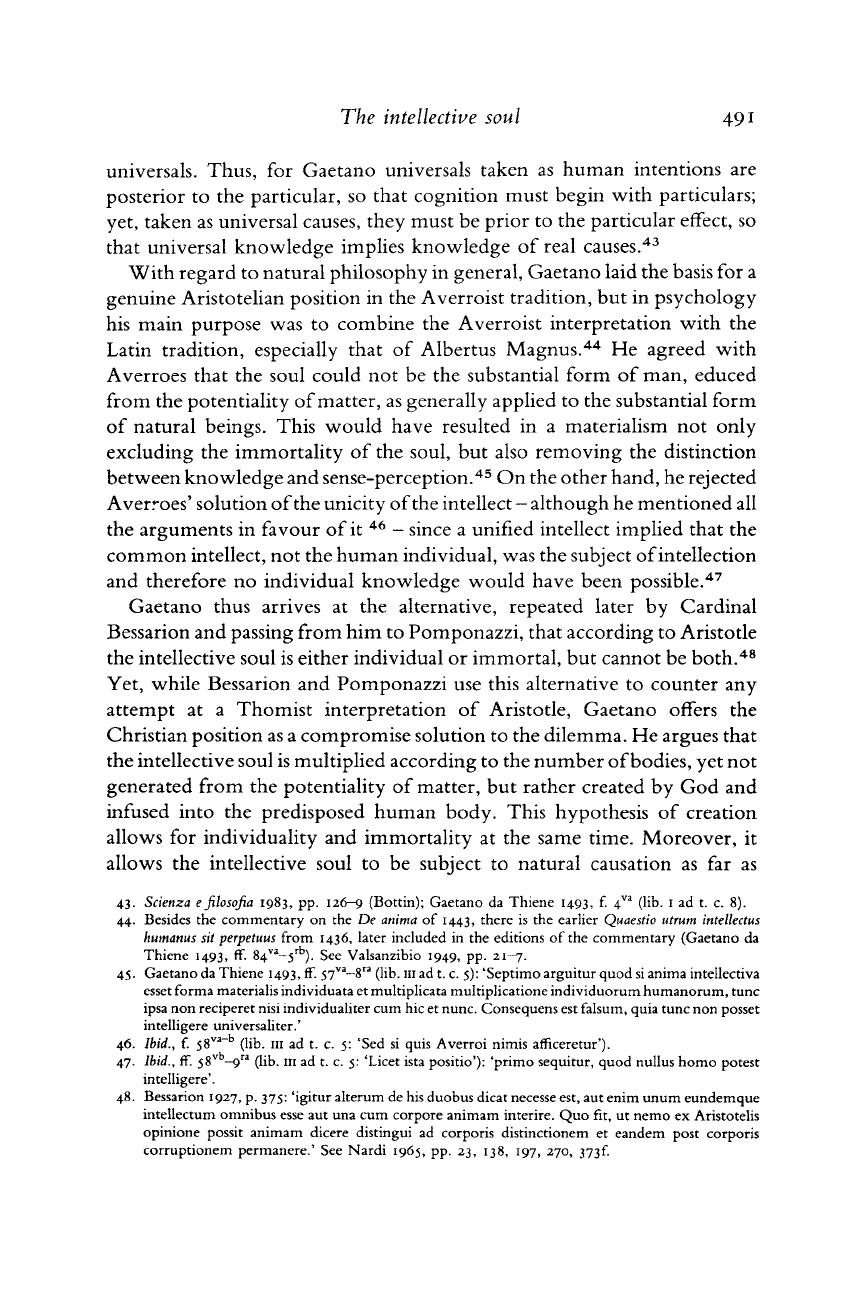
The
intellective
soul
491
universals. Thus, for Gaetano universals taken as human intentions are
posterior
to the
particular,
so that cognition must begin with
particulars;
yet, taken as universal causes, they must be
prior
to the
particular
effect, so
that
universal knowledge implies knowledge of
real
causes.
43
With
regard
to
natural
philosophy in general, Gaetano laid the basis for a
genuine Aristotelian position in the Averroist tradition, but in psychology
his main purpose was to combine the Averroist interpretation with the
Latin
tradition, especially that of Albertus Magnus.
44
He agreed with
Averroes
that the soul could not be the substantial form of man, educed
from
the potentiality
of
matter,
as generally applied to the substantial form
of
natural beings. This would have resulted in a materialism not only
excluding the immortality of the soul, but also removing the distinction
between knowledge and sense-perception.
45
On the other hand, he rejected
Averroes'
solution
of
the
unicity
of
the
intellect
—
although he mentioned all
the
arguments in favour of it
46
- since a unified intellect implied that the
common intellect, not the human individual, was the subject
of
intellection
and
therefore no individual knowledge would have been possible.
47
Gaetano
thus arrives at the alternative, repeated later by Cardinal
Bessarion
and passing from him to Pomponazzi, that according to Aristotle
the
intellective soul is either individual or immortal, but cannot be both.
48
Yet,
while
Bessarion and Pomponazzi use this alternative to counter any
attempt
at a Thomist interpretation of Aristotle, Gaetano offers the
Christian
position as a compromise solution to the dilemma. He argues that
the
intellective soul is multiplied according to the number
of
bodies, yet not
generated
from the potentiality of
matter,
but
rather
created by God and
infused into the predisposed human body. This hypothesis of creation
allows for individuality and immortality at the same time. Moreover, it
allows the intellective soul to be subject to natural causation as far as
43. Scienza e
jilosofia
1983, pp. 126-9
(Bottin);
Gaetano da
Thiene
1493, f. 4
va
(lib. 1 ad t. c. 8).
44.
Besides
the
commentary
on the De anima of 1443,
there
is the
earlier
Quaestio utrum intellectus
humanus sit perpetuus
from
1436,
later
included
in the
editions
of the
commentary
(Gaetano da
Thiene
1493, flf.
84
va
-5
rb
).
See Valsanzibio 1949, pp. 21-7.
45. Gaetano da
Thiene
1493, ff. 57
va
-8
ra
(lib. m ad t. c. 5):
'Septimo
arguitur
quod
si
anima
intellectiva
esset
forma
materialis
individuata
et
multiplicata
multiplicatione
individuorum
humanorum,
tunc
ipsa
non
reciperet
nisi
individualiter
cum hie et
nunc.
Consequens
est
falsum,
quia
tunc
non
posset
intelligere
universaliter.'
46. Ibid., f.
58
va_b
(lib. in ad t. c. 5: 'Sed si
quis
Averroi
nimis
amceretur').
47. Ibid., ff.
58
vb
—9"
(lib. in ad t. c. 5: 'Licet
ista
positio'):
'primo
sequitur,
quod
nullus homo
potest
intelligere'.
48.
Bessarion
1927, p. 375^
'igitur
alterum
de his
duobus
dicat
necesse
est, aut
enim
unum
eundemque
intellectum
omnibus
esse
aut una cum
corpore
animam
interire.
Quo fit, ut
nemo
ex
Aristotelis
opinione
possit
animam
dicere
distingui
ad
corporis
distinctionem
et
eandem
post
corporis
corruptionem
permanere.'
See Nardi 1965, pp. 23, 138, 197, 270,
373f.
Cambridge Histories Online © Cambridge University Press, 2008
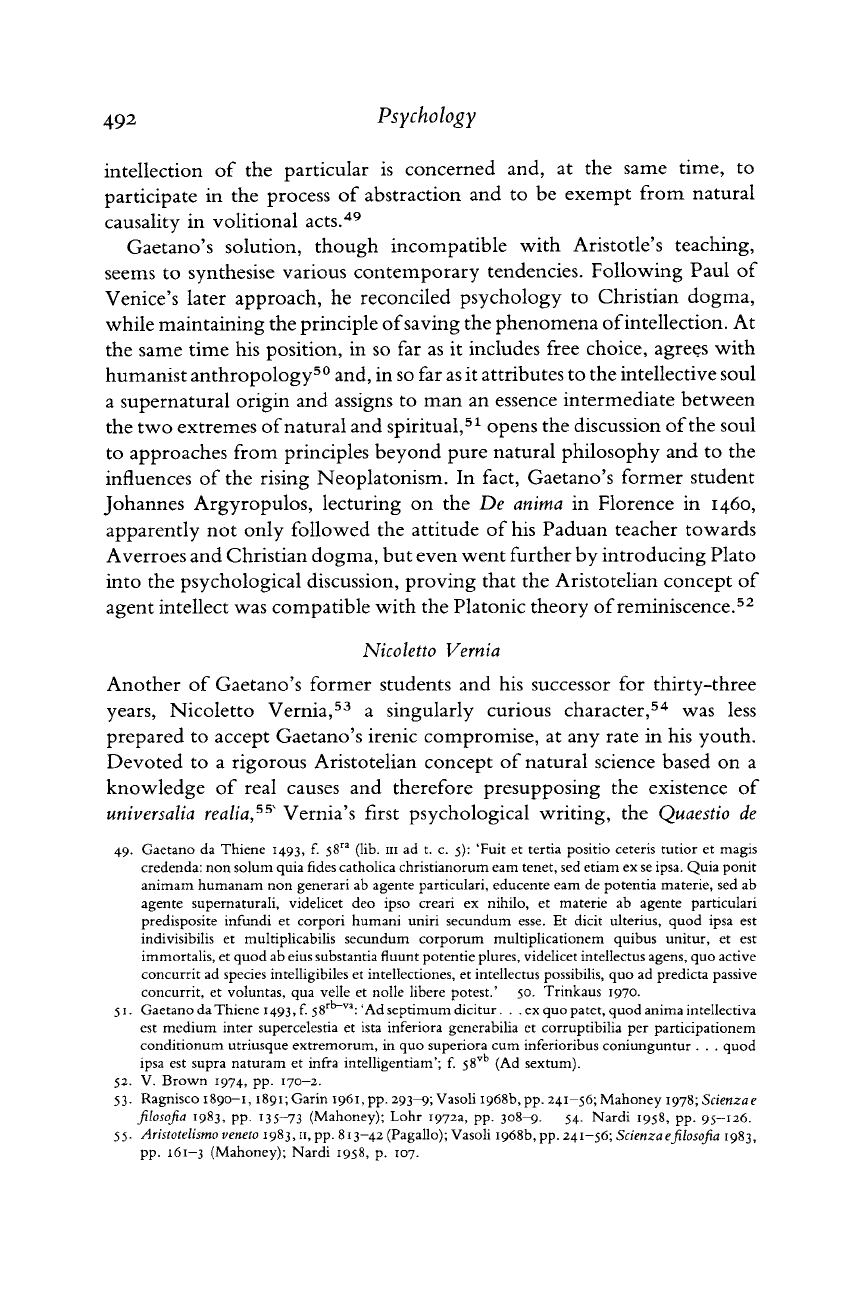
492
Psychology
intellection
of the
particular
is
concerned
and, at the
same
time,
to
participate
in the
process
of
abstraction
and to be
exempt
from
natural
causality
in volitional
acts.
49
Gaetano's
solution, though
incompatible
with
Aristotle's
teaching,
seems
to synthesise
various
contemporary
tendencies. Following
Paul
of
Venice's
later
approach,
he
reconciled
psychology to
Christian
dogma,
while
maintaining
the
principle
of
saving
the
phenomena
of
intellection.
At
the
same
time
his position, in so far as it includes
free
choice,
agrees
with
humanist
anthropology
50
and,
in so
far
as
it
attributes
to
the
intellective
soul
a
supernatural
origin and assigns to man an essence
intermediate
between
the
two
extremes
of
natural
and
spiritual,
51
opens the discussion
of
the
soul
to
approaches
from
principles
beyond
pure
natural
philosophy and to the
influences
of the rising Neoplatonism. In
fact,
Gaetano's
former
student
Johannes
Argyropulos,
lecturing
on the De
anima
in
Florence
in 1460,
apparently
not only followed the
attitude
of his
Paduan
teacher
towards
Averroes
and
Christian
dogma,
but
even went
further
by
introducing
Plato
into
the
psychological
discussion, proving
that
the
Aristotelian
concept
of
agent
intellect was
compatible
with the
Platonic theory
of
reminiscence.
52
Nicoletto
Vernia
Another
of
Gaetano's
former
students and his
successor
for
thirty-three
years,
Nicoletto
Vernia,
53
a singularly
curious
character,
54
was less
prepared
to
accept
Gaetano's
irenic
compromise,
at any
rate
in his
youth.
Devoted
to a
rigorous
Aristotelian
concept
of
natural
science
based on a
knowledge
of
real
causes
and
therefore
presupposing the
existence
of
universalia
realia,
5
5
"
Vernia's
first
psychological writing, the
Quaestio
de
49. Gaetano da Thiene 1493, f. 58" (lib.
111
ad t. c. 5): 'Fuit et tertia positio ceteris tutior et magis
credenda: non solum quia fides catholica christianorum earn tenet, sed etiam ex se ipsa. Quia ponit
animam humanam non generari ab agente particulari, educente earn de potentia materie, sed ab
agente supernaturali, videlicet deo ipso creari ex nihilo, et materie ab agente particulari
predisposite infundi et corpori humani uniri
secundum
esse.
Et dicit ulterius, quod ipsa est
indivisibilis et multiplicabilis secundum corporum multiplicationem quibus unitur, et est
immortalis, et quod ab
eius
substantia fluunt potentie plures, videlicet intellectus agens, quo active
concurrit ad
species
intelligibiles et intellectiones, et intellectus possibilis, quo ad predicta passive
concurrit, et voluntas, qua velie et
nolle
libere potest.' 50. Trinkaus 1970.
51.
Gaetano da Thiene 1493, f. 58
rb_va
:
'Ad
septimum dicitur... ex quo patet, quod anima intellectiva
est medium inter supercelestia et ista inferiora generabilia et corruptibilia per participationem
conditionum utriusque extremorum, in quo superiora cum inferioribus coniunguntur . . . quod
ipsa est supra naturam et infra intelligentiam'; f. 58
vb
(Ad sextum).
52.
V. Brown 1974, pp. 170—2.
53.
Ragnisco
1890-1,1891;
Garin
1961,
pp. 293-9; Vasoli 1968b,pp. 241-56; Mahoney
1978;
Scienzae
filosofia
1983,
pp. 135-73 (Mahoney); Lohr 1972a, pp.
308-9.
54. Nardi 1958, pp. 95-126.
55.
Aristotelismo
veneto
1983,11,
pp. 813-42 (Pagallo); Vasoli 1968b, pp. 241-56;
Scienza
e
filosofia
1983,
pp.
161-3 (Mahoney); Nardi 1958, p. 107.
Cambridge Histories Online © Cambridge University Press, 2008
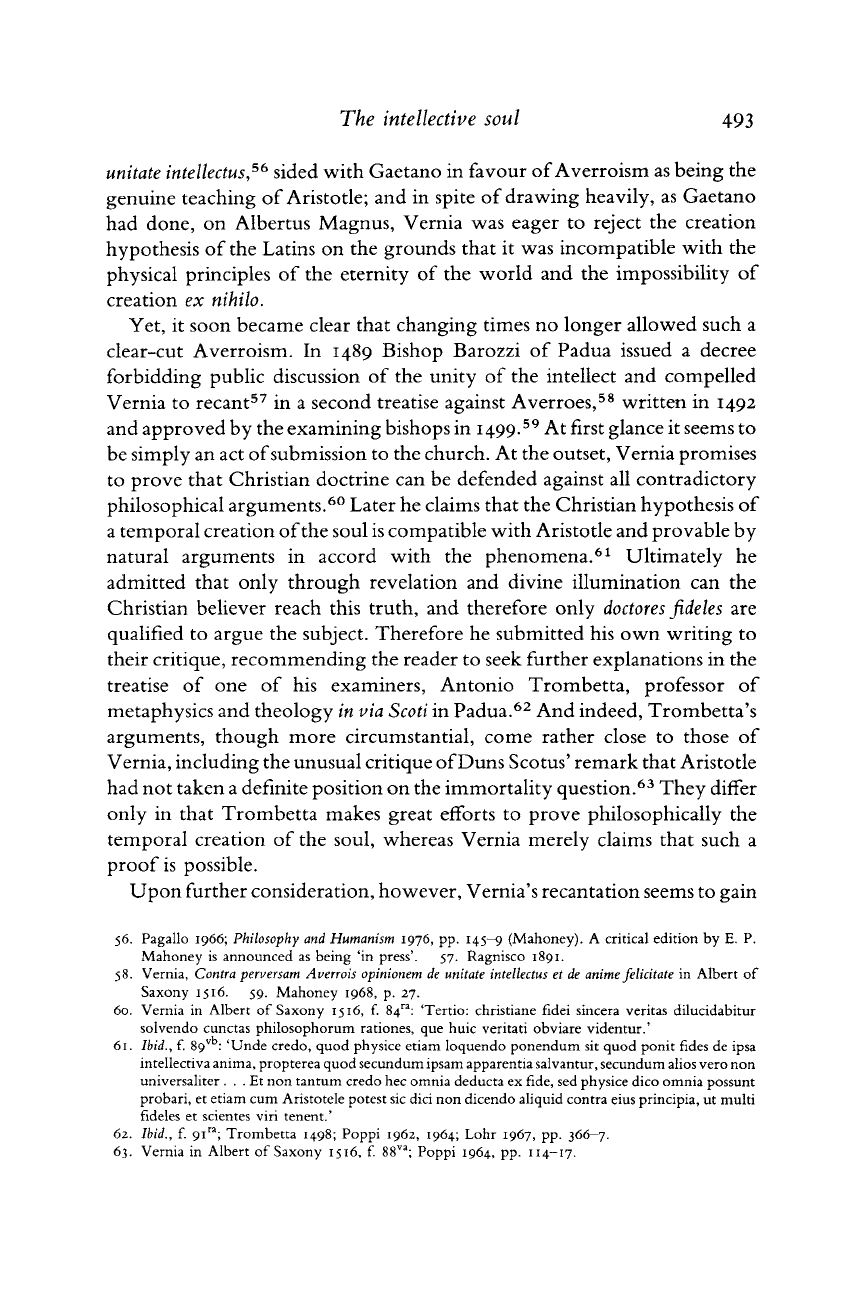
The
intellective
soul
493
unitate
intellectus,
56
sided with
Gaetano
in favour
of
Averroism
as being the
genuine teaching of
Aristotle;
and in spite of
drawing
heavily, as Gaetano
had
done, on Albertus Magnus,
Vernia
was
eager
to
reject
the
creation
hypothesis of the
Latins
on the grounds
that
it was incompatible with the
physical
principles of the eternity of the world and the impossibility of
creation
ex
nihilo.
Yet,
it soon became
clear
that
changing times no longer allowed such a
clear-cut
Averroism. In 1489 Bishop
Barozzi
of
Padua
issued a
decree
forbidding
public discussion of the unity of the intellect and compelled
Vernia
to
recant
57
in a second
treatise
against
Averroes,
58
written in 1492
and
approved
by the examining bishops in
1499.
59
At first
glance
it seems to
be
simply an
act
of
submission to the
church.
At the outset,
Vernia
promises
to
prove
that
Christian
doctrine can be defended against all
contradictory
philosophical
arguments.
60
Later
he claims
that
the
Christian
hypothesis of
a
temporal
creation
of
the
soul is
compatible
with
Aristotle
and
provable
by
natural
arguments in
accord
with the phenomena.
61
Ultimately he
admitted
that
only through revelation and divine illumination can the
Christian
believer
reach
this
truth,
and
therefore
only
doctores jideles
are
qualified to
argue
the subject.
Therefore
he submitted his own writing to
their
critique,
recommending the
reader
to seek
further
explanations
in the
treatise
of one of his
examiners,
Antonio
Trombetta,
professor of
metaphysics
and theology in via
Scoti
in
Padua.
62
And indeed,
Trombetta's
arguments,
though
more
circumstantial,
come
rather
close to those of
Vernia,
including the unusual
critique
of
Duns
Scotus'
remark
that
Aristotle
had
not taken
a
definite position on the
immortality
question.
63
They differ
only in
that
Trombetta
makes
great
efforts to prove philosophically the
temporal
creation
of the soul, whereas
Vernia
merely claims
that
such a
proof
is possible.
Upon
further
consideration,
however,
Vernia's
recantation
seems to gain
56. Pagallo 1966;
Philosophy
and Humanism 1976, pp. 145—9 (Mahoney). A critical
edition
by E. P.
Mahoney is announced as being 'in press'. 57. Ragnisco 1891.
58. Vernia,
Contra
perversam
Averrois
opinionem de unitate
intellectus
et de
anime
felicitate
in Albert of
Saxony 1516. 59. Mahoney 1968, p. 27.
60. Vernia in Albert of Saxony 1516, f. 84™: 'Tertio: christiane fidei sincera Veritas dilucidabitur
solvendo cunctas philosophorum rationes, que huic veritati obviare videntur.'
61.
Ibid., f.
89
vb
:
'Unde credo, quod physice etiam loquendo ponendum sit quod ponit
fides
de ipsa
intellectiva anima, propterea quod secundum ipsam apparentia salvantur, secundum
alios
vero non
universaliter . . . Et non tantum credo hec omnia deducta ex fide, sed physice dico omnia possunt
probari, et etiam cum Aristotele potest sic dici non dicendo aliquid contra
eius
principia, ut multi
fideles
et
scientes
viri tenent.'
62. Ibid., f. 91"; Trombetta 1498; Poppi 1962, 1964; Lohr 1967, pp. 366—7.
63. Vernia in Albert of Saxony 1516, f.
88
va
;
Poppi 1964, pp.
114-17.
Cambridge Histories Online © Cambridge University Press, 2008
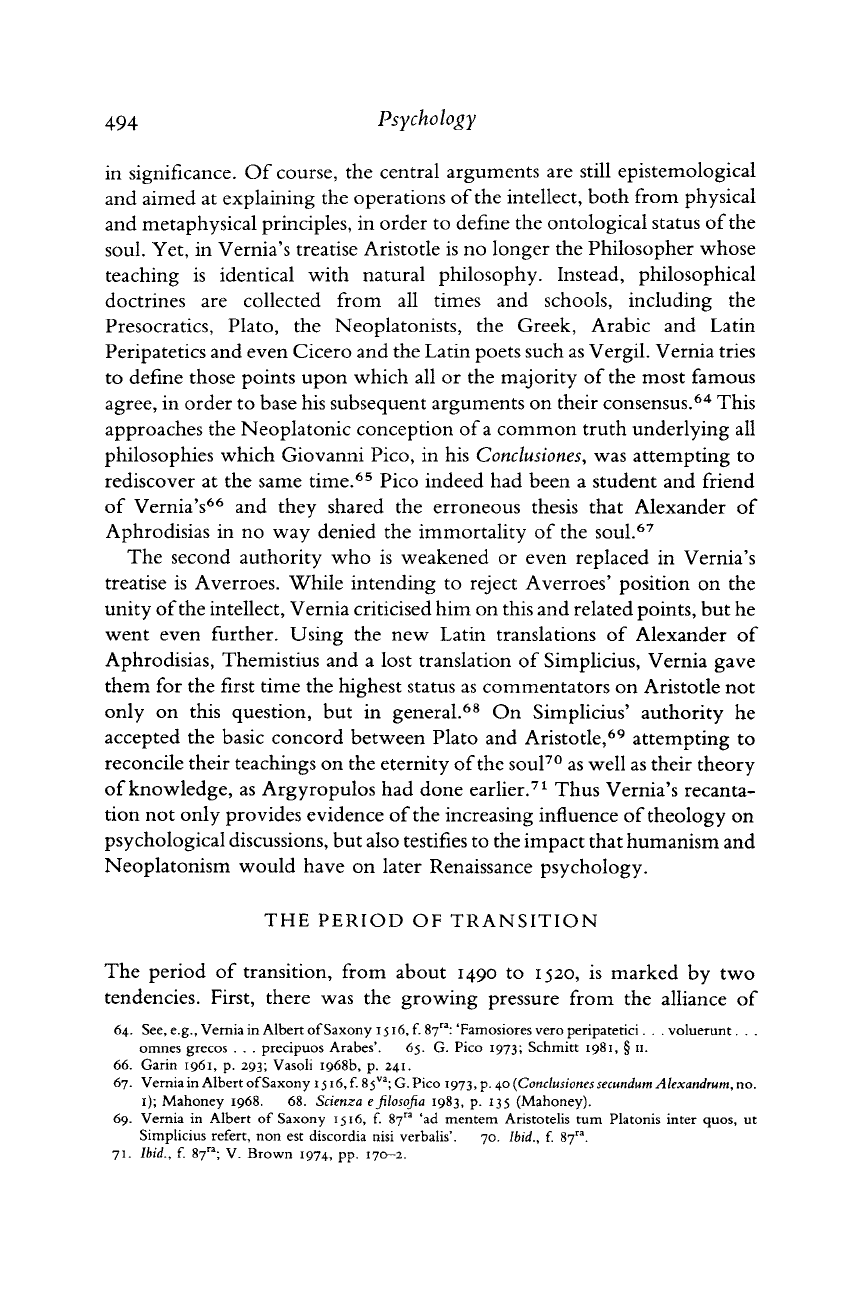
494
Psychology
in significance. Of course, the central arguments are still epistemological
and
aimed at explaining the operations of the intellect, both from physical
and
metaphysical principles, in
order
to define the ontological status of the
soul. Yet, in Vernia's treatise Aristotle is no longer the Philosopher whose
teaching is identical with natural philosophy. Instead, philosophical
doctrines
are collected from all times and schools, including the
Presocratics,
Plato, the Neoplatonists, the Greek, Arabic and Latin
Peripatetics
and even Cicero and the Latin poets such as Vergil. Vernia tries
to
define those points upon which all or the majority of the most famous
agree,
in
order
to base his subsequent arguments on their consensus.
64
This
approaches
the Neoplatonic conception of
a
common truth underlying all
philosophies which Giovanni Pico, in his
Conclusiones,
was attempting to
rediscover
at the same time.
65
Pico indeed had been a student and friend
of
Vernia's
66
and they shared the erroneous thesis that Alexander of
Aphrodisias in no way denied the immortality of the soul.
67
The
second authority who is weakened or even replaced in Vernia's
treatise
is Averroes. While intending to reject Averroes' position on the
unity
of
the
intellect, Vernia criticised him on this and related points, but he
went even further. Using the new Latin translations of Alexander of
Aphrodisias, Themistius and a lost translation of Simplicius, Vernia gave
them for the first time the highest status as commentators on Aristotle not
only on this question, but in general.
68
On Simplicius' authority he
accepted
the basic concord between Plato and Aristotle,
69
attempting to
reconcile
their teachings on the eternity
of
the
soul
70
as
well
as their theory
of
knowledge, as Argyropulos had done earlier.
71
Thus Vernia's
recanta-
tion not only provides evidence of
the
increasing influence of theology on
psychological discussions, but also testifies to the impact
that
humanism and
Neoplatonism would have on later Renaissance psychology.
THE
PERIOD
OF
TRANSITION
The
period of transition, from about 1490 to 1520, is marked by two
tendencies.
First,
there was the growing pressure from the alliance of
64. See, e.g., Vernia in Albert of Saxony 1516, f. 87":
'Famosiores
vero
peripatetici. . . voluerunt. . .
omnes
grecos
. . .
precipuos
Árabes'. 65. G. Pico 1973; Schmitt 1981, § 11.
66. Garin 1961, p. 293; Vasoli 1968b, p. 241.
67. Vernia in Albert of Saxony 1516, f.
85™;
G.Pico 1973, p. 40
(Conclusiones
secundum Alexandrum, no.
1);
Mahoney 1968. 68. Scienza e
filosofía
1983, p. 135 (Mahoney).
69. Vernia in Albert of Saxony 1516, f. 87™ 'ad
mentem
Aristotelis
turn
Platonis
inter
quos,
ut
Simplicius
refert, non est
discordia
nisi
verbalis'. 70. Ibid., f. 87".
71.
Ibid., f. 87"; V. Brown 1974, pp. 170-2.
Cambridge Histories Online © Cambridge University Press, 2008
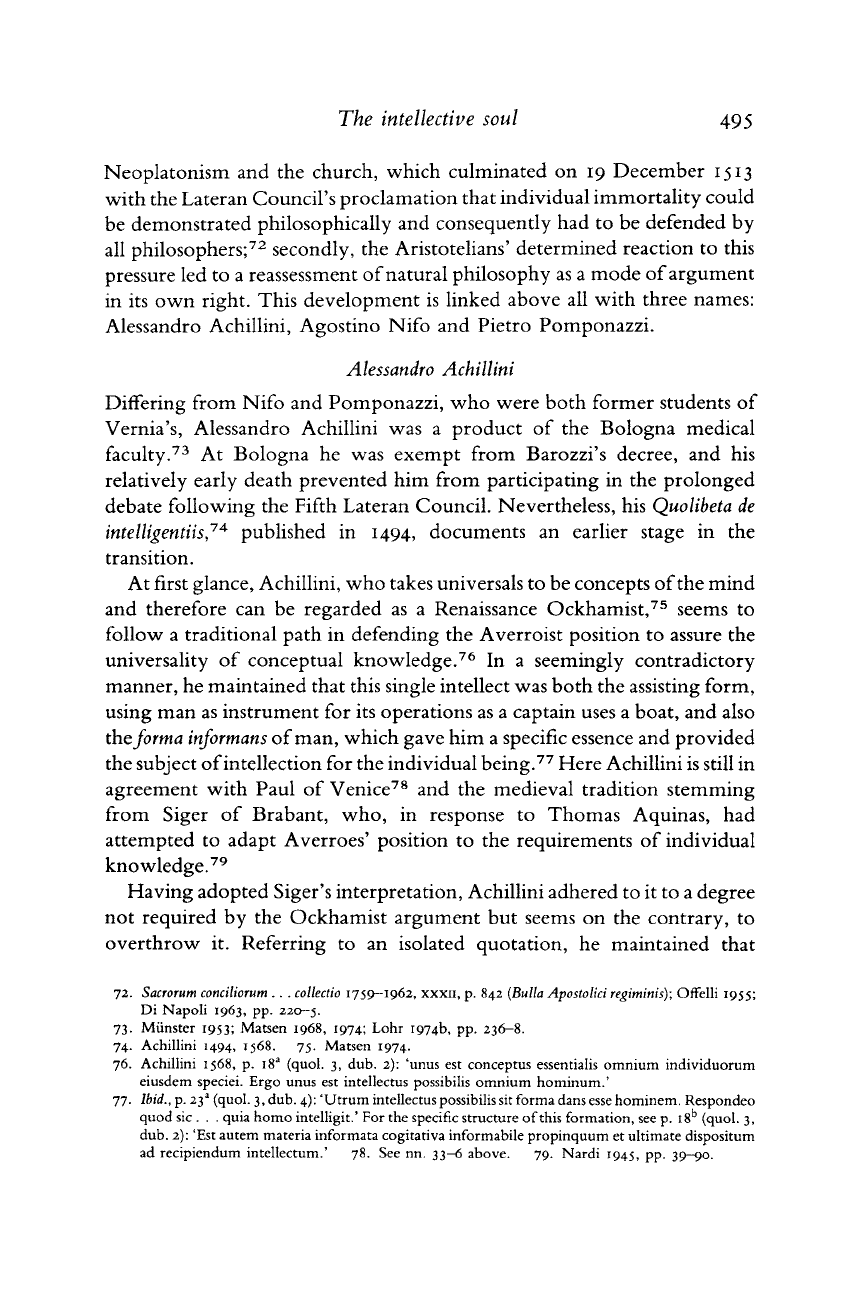
The
intellective
soul
495
Neoplatonism and the church, which culminated on 19 December 1513
with the
Lateran
Council's proclamation that individual immortality could
be demonstrated philosophically and consequently had to be defended by
all philosophers;
72
secondly, the Aristotelians' determined reaction to this
pressure
led to a reassessment
of
natural
philosophy as a mode
of
argument
in its own right. This development is linked above all with three names:
Alessandro Achillini, Agostino
Nifo
and Pietro Pomponazzi.
Alessandro
Achillini
Differing from
Nifo
and Pomponazzi, who were both former students of
Vernia's,
Alessandro Achillini was a product of the Bologna medical
faculty.
73
At Bologna he was exempt from Barozzi's decree, and his
relatively early death prevented him from participating in the prolonged
debate
following
the Fifth
Lateran
Council. Nevertheless, his
Quolibeta
de
intelligentiis,
74
published in 1494, documents an earlier stage in the
transition.
At
first glance, Achillini, who takes universals to be concepts
of
the mind
and therefore can be regarded as a Renaissance Ockhamist,
75
seems to
follow
a traditional path in defending the Averroist position to assure the
universality of conceptual knowledge.
76
In a seemingly contradictory
manner,
he maintained that this
single
intellect was both the assisting form,
using
man as instrument for its operations as a captain uses a boat, and also
the
forma
informans
of
man,
which gave him a specific essence and provided
the subject
of
intellection for the individual being.
77
Here Achillini is
still
in
agreement
with Paul of Venice
78
and the medieval tradition stemming
from
Siger of
Brabant,
who, in response to Thomas Aquinas, had
attempted
to adapt Averroes' position to the requirements of individual
knowledge.
79
Having adopted Siger's interpretation, Achillini adhered to it to a degree
not required by the Ockhamist argument but seems on the
contrary,
to
overthrow
it. Referring to an isolated quotation, he maintained that
72. Sacromm conciliomm . . .
collectio
1759-1962, xxxn, p. 842 (Bulla Apostolici regiminis); Offelli 1955;
Di
Napoli
1963, pp.
220-5.
73.
Minister
1953;
Matsen
1968, 1974; Lohr 1974b, pp.
236-8.
74.
Achillini
1494, 1568. 75.
Matsen
1974.
76.
Achillini
1568, p. i8
a
(quol.
3, dub. 2):
'unus
est
conceptus
essentialis
omnium
individuorum
eiusdem
speciei.
Ergo
unus
est
intellectus
possibilis
omnium
hominum.'
77.
Ibid., p. 23
s
(quol.
3, dub. 4): 'Utrum
intellectus
possibilis
sit
forma
dans
esse
hominem.
Respondeo
quod
sic . . .
quia
homo
intelligit.'
For the
specific
structure
of
this
formation,
see p. i8
b
(quol.
3,
dub. 2): 'Est
autem
materia
informata
cogitativa
informabile
propinquum
et
ultimate
dispositum
ad
recipiendum
intellectum.'
78. See nn. 33-6
above.
79. Nardi 1945, pp.
39-90.
Cambridge Histories Online © Cambridge University Press, 2008
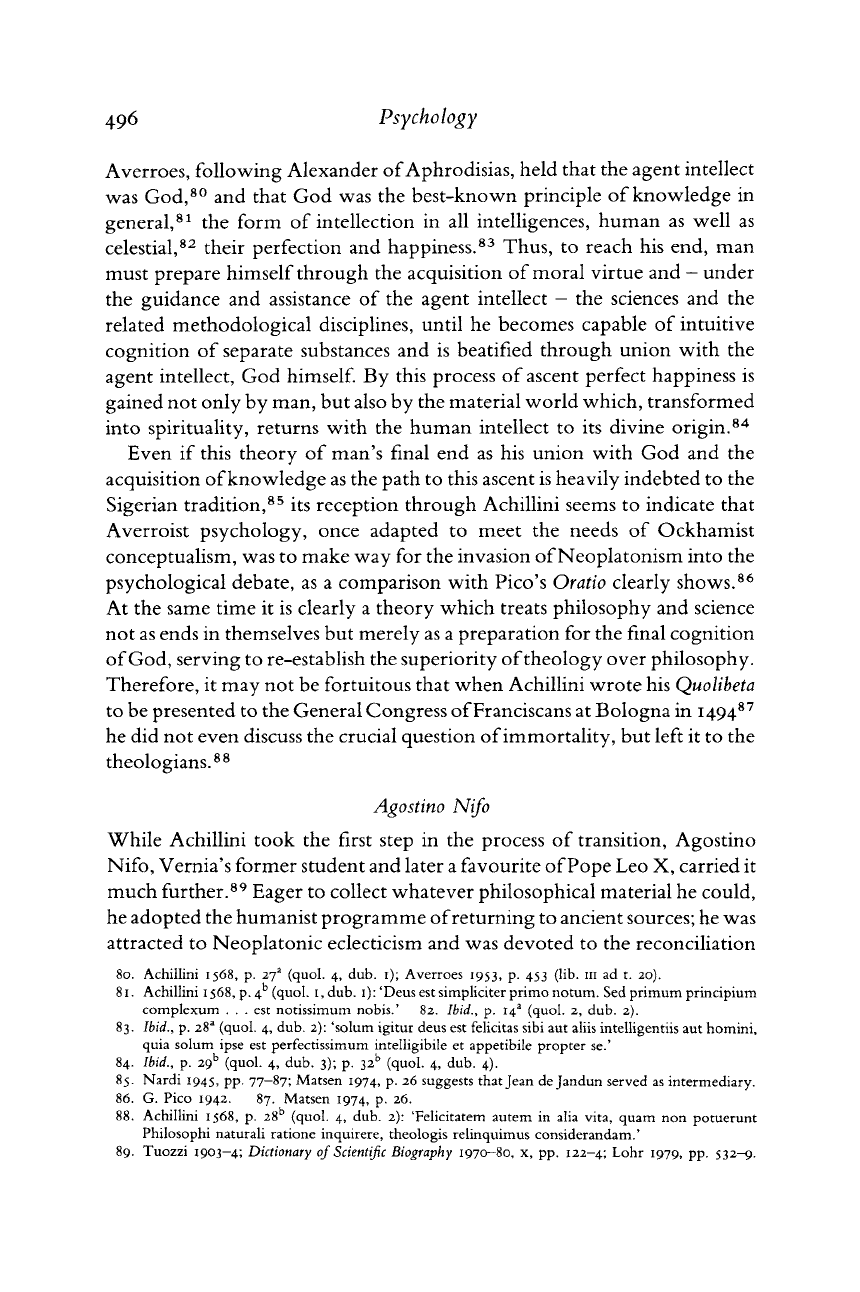
496
Psychology
Averroes,
following
Alexander
of
Aphrodisias, held that the agent intellect
was God,
80
and that God was the best-known principle of knowledge in
general,
81
the form of intellection in all intelligences, human as
well
as
celestial,
82
their perfection and happiness.
83
Thus, to reach his end, man
must prepare himself through the acquisition of
moral
virtue and - under
the guidance and assistance of the agent intellect
—
the sciences and the
related
methodological disciplines, until he becomes capable of intuitive
cognition of separate substances and is beatified through union with the
agent intellect, God himself. By this process of ascent perfect happiness is
gained not only by man, but also by the material world which, transformed
into spirituality, returns with the human intellect to its divine origin.
84
Even
if this theory of man's final end as his union with God and the
acquisition
of
knowledge as the path to this ascent is heavily indebted to the
Sigerian tradition,
85
its reception through Achillini seems to indicate that
Averroist
psychology, once adapted to meet the needs of Ockhamist
conceptualism, was to make way for the invasion
of
Neoplatonism into the
psychological debate, as a comparison with Pico's
Oratio
clearly shows.
86
At
the same time it is clearly a theory which treats philosophy and science
not as ends in themselves but merely as a preparation for the final cognition
of
God, serving to re-establish the superiority
of
theology over philosophy.
Therefore,
it may not be fortuitous that when Achillini wrote his
Quolibeta
to
be presented to the General Congress
of
Franciscans
at Bologna in
1494
s
7
he did not even discuss the crucial question
of
immortality,
but left it to the
theologians.
88
Agostino
Nifo
While Achillini took the first step in the process of transition, Agostino
Nifo,
Vernia's former student and later a favourite
of
Pope Leo X,
carried
it
much further.
89
Eager
to collect whatever philosophical material he could,
he adopted the humanist
programme
of
returning
to ancient
sources;
he was
attracted
to Neoplatonic eclecticism and was devoted to the reconciliation
80.
Achillini
1568, p. 27
a
(quol.
4, dub. 1);
Averroes
1953, p. 453 (lib.
111
ad t. 20).
81.
Achillini
1568, p. 4
b
(quol.
1, dub. 1):
'Deus
est
simpliciter
primo notum.
Sed
primum
principium
complexum
... est
notissimum
nobis.'
82. Ibid., p. I4
a
(quol.
2, dub. 2).
83. Ibid., p. 28
a
(quol.
4, dub. 2):
'solum
igitur
deus
est
felicitas sibi
aut
aliis
intelligentiis
aut
homini,
quia
solum
ipse
est
perfectissimum
intelligibile
et
appetibile
propter
se.'
84. Ibid., p. 29
b
(quol.
4, dub. 3); p. 32
b
(quol.
4, dub. 4).
85. Nardi 1945, pp. 77-87;
Matsen
1974, P- 26
suggests
that
Jean
de
Jandun
served
as
intermediary.
86. G.
Pico
1942. 87.
Matsen
1974, p. 26.
88.
Achillini
1568, p. 28
b
(quol.
4, dub. 2):
'Felicitatem
autem
in
alia
vita,
quam
non
potuerunt
Philosophi
naturali
ratione
inquirere,
theologis
relinquimus
considerandam.'
89. Tuozzi
1903—4;
Dictionary of Scientific Biography
1970-80,
x, pp. 122-4; Lohr 1979, pp.
532—9.
Cambridge Histories Online © Cambridge University Press, 2008
